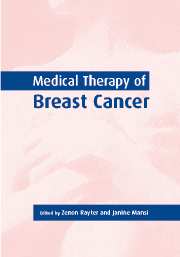Book contents
- Frontmatter
- Contents
- List of contributors
- 1 History of breast cancer therapy
- 2 Chemoprevention of breast cancer
- 3 Familial breast cancer
- 4 Hormone replacement therapy and breast cancer
- 5 Screening for breast cancer
- 6 The management of in situ breast cancer
- 7 Adjuvant systemic therapy
- 8 Adjuvant radiotherapy in the management of breast cancer
- 9 Predictors of response and resistance to medical therapy
- 10 Primary medical therapy in breast cancer
- 11 Medical therapy of advanced disease
- 12 Experimental approaches
- 13 The place of bisphosphonates in the management of breast cancer
- 14 Palliative care in breast cancer
- Index
3 - Familial breast cancer
Published online by Cambridge University Press: 06 January 2010
- Frontmatter
- Contents
- List of contributors
- 1 History of breast cancer therapy
- 2 Chemoprevention of breast cancer
- 3 Familial breast cancer
- 4 Hormone replacement therapy and breast cancer
- 5 Screening for breast cancer
- 6 The management of in situ breast cancer
- 7 Adjuvant systemic therapy
- 8 Adjuvant radiotherapy in the management of breast cancer
- 9 Predictors of response and resistance to medical therapy
- 10 Primary medical therapy in breast cancer
- 11 Medical therapy of advanced disease
- 12 Experimental approaches
- 13 The place of bisphosphonates in the management of breast cancer
- 14 Palliative care in breast cancer
- Index
Summary
Introduction
Breast cancer affects about 1 in 12 women and the annual incidence of breast cancer in the UK is 25 000. Of the known risk factors for breast cancer a positive family history appears to be the most important.
The recurrence of breast cancer in families may be a result of genetic factors, environmental factors or coincidence. Given the high frequency of breast cancer in Western populations most families in which two cases have occurred will be as a result of a coincidence. Population studies have suggested that most of the excess genetic risk is due to high penetrance autosomal dominant genes. Members of such families usually have cancer at an early age, an excess of bilateral, multifocal breast cancer and sometimes other related cancers such as of the ovary, prostate and colon. Inherited susceptibility accounts for only about 5% of all breast cancer cases (Claus et al., 1991), but about 25% of early onset cases (<30 years). Since there is such a strong association with early age of onset and the presence of a genetic susceptibility this is a strong indicator of risk in families where more than one case has occurred.
BRCA1
In October 1994 the first gene for susceptibility to breast cancer, BRCA1, was identified (Miki et al., 1994). BRCA1 had been localized previously on chromosome 17q21 in 1990 by linkage analysis studies (Hall et al., 1990).
- Type
- Chapter
- Information
- Medical Therapy of Breast Cancer , pp. 61 - 71Publisher: Cambridge University PressPrint publication year: 2003



